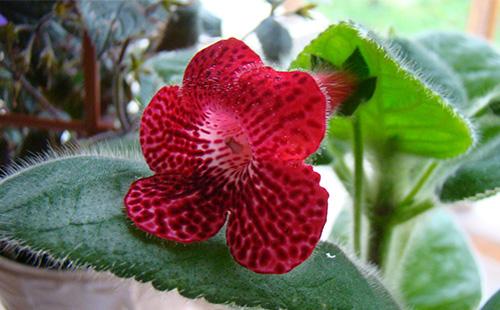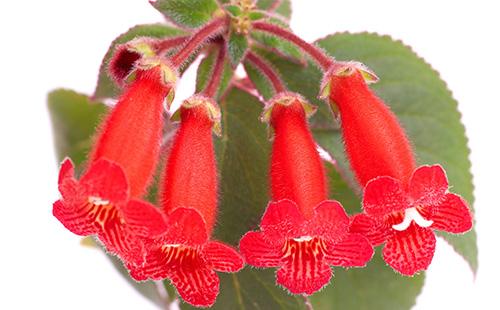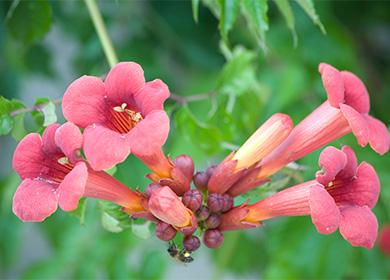The content of the article
The natural habitat of the koleriya is South and Central America. It settles mainly in the tropical highlands. In nature, grows in a changing climate, adapts to the rainy and drought seasons. Natural resistance helps the plant easily adapt to the microclimate of the apartment.
Description and Features
The flower koleriya belongs to the genus of the same name, consisting of about 65 different species. Among them are grassy perennials and shrubs. They are characterized by tuberous scaly rhizomes - rhizomes.
The leaves are egg-shaped, slightly oblong, located opposite to the stems. The surface is fleecy, the edges are steep. Coloring from light olive to dark green. A characteristic feature of the leaves - bright or red veins are distinctly distinguished on them. Hybrid species are distinguished by increased decorativeness, silver or bronze tint of leaves.
Bloom koleriya abundantly. Bell-shaped flowers are single, or gather two or three pieces on short axillary peduncles. In some varieties, the flowers are similar in shape to a thimble. The color of natural species is dominated by red, orange, brown, pink shades. Almost always there is an additional color in the form of spots, specks, strokes.
Different types of colors are easily crossed. In addition to natural forms, many hybrid varieties have been bred by breeders. They differ in more interesting, saturated colors. There are varieties with golden, amethyst, tiger flowers.
Popular views
In room culture, many species of collieries are grown. Almost all of them have interesting hybrid varieties. The most famous are 11 varieties.
- Bogotskaya. In nature, grows on rocky soil. The stems are straight, without branching. Oval dark green leaves are covered with fairly rare whitish villi. Two flowers bloom on each peduncle. The flowers are scarlet above, the mottled ones at the bottom.
- Majestic. The foliage is glossy, grassy in color, the surface is “quilted”. The flowers are large, bright. Color orange, with an admixture of burgundy.
- Hairy. Shoots straight, with a slight whitish pubescence. A pronounced bronze hue of the leaves is characteristic. The outer side of the flower is scarlet, the inside is lilac, with burgundy interspersed.
- Spikelet. An interesting miniature variety, originally from Mexico. Leaves are oblong, with a pointed end. The color is grayish, the pubescence is silvery. Bright scarlet flowers gather in the likeness of an ear.
- Linden. A low bush, up to 30 cm. The plant is densely pubescent. On a green background of leaves, light veins are distinctly expressed. Flowers bloom individually or gather in three pieces. Outside, the flower is white, inside - purple.
- Digitalis. It differs from other varieties in more dense pubescence, an interesting form of flowers.Large leaves are ovoid in shape. The flowers are axillary, single, white-violet colors.
- Uneven. One of the smallest varieties. The flowers are bright red, elongated. On the inside is a purple pattern.
- Pleasant. Mountain tall variety of colors. Variegated leaves are green, interspersed with silver and brown. The flowers are elongated, red with white.
- Koleria fluffy. The center of the leaves is green, the edges are red. Differs in dense pubescence. The color of the flowers combines red and yellow.
- Tubal flowered. Tall variety, up to 60 cm. Shoots are straight, not branched. The foliage is oval, with a sharp end, grassy in color. The flowers are orange-red, tubular, the same thickness along the entire length.
- Woolen. The leaves are covered with a brownish pile. Flowers in the form of a tube. They differ in interesting colors - brown streaks stand out against a beige background. The edges of the petals are outlined in white.
Care for color, soil and moisture requirements
Caring for a koleriya flower is not very difficult - it is a fairly unpretentious culture. She easily adapts to the conditions of the apartment. The main requirements for good growth and friendly flowering are full lighting and timely watering.
- Lighting. Koleria prefers bright lighting. It is placed on the southern, eastern, western windows. In summer, they always shade with tulle so that delicate leaves do not receive a sunburn. From the north side it can actively develop, but it will not bloom.
- Temperature. Koleria prefers moderate heat around 18-24 ° C. When the temperature rises, it wilts, withers. In hot weather, the room is ventilated daily, the color is removed from the window. In winter, the air temperature should not fall below 15 ° C.
- Watering. Properly water the color on the edge of the pot, avoiding droplets falling on the leaves and stems. In the reviews, experienced flower growers are advised to use wick watering. Another good option - watering by immersion. Water is surely softened - they are upheld or a means for aquariums added. Watered sparingly, but maintain stable humidity. Rarely watered in winter, in small doses.
- Humidity. In hot weather, colors need high humidity. But spraying is contraindicated - from the water there are spots on the foliage, the risk of decay increases. Humidity is increased in other ways - the pot is placed on a tray with a filler, systematically moisturize it. The use of special humidifiers is welcome.
- The soil. Choose a nutritious, light soil with low acidity. Use a shop soil mixture for the Gesneriaceae or mix hardwood, peat, turf, sand and perlite. Charcoal is used as a useful additive.
- Transfer. Transplanted annually in early spring. They act carefully so as not to damage the rhizome. Some gardeners prefer to use the transshipment method. The root system grows to the sides, so the pot use a wide, shallow depth. Drainage is a prerequisite.
- Top dressing. Choose fertilizers for violets or gesneriaceae. Sometimes you can feed organics. Fertilizers begin to be applied in early spring, at the same time as active growth begins. In the summer, two-week intervals between dressings are maintained. In winter, there is no acute need for nutrients - top dressing is temporarily suspended.

Breeding methods
Koleriya is simple not only in leaving, but also in reproduction. It grows rapidly, young specimens bloom early. Florists use three methods of reproduction.
- Seeds. Sowing seeds begins in mid-winter. Flat containers are filled with a light soil mixture of sheet earth and sand. Seeds are distributed over the surface of the substrate without seeding, sprayed from a spray bottle and covered with a film. The container is placed in a warm place. Keep at a temperature of at least 20 ° C. With the advent of seedlings, the film is removed. The first time a pick is carried out at the stage of formation of a pair of real leaves. Seedlings are transplanted into a box, maintaining a distance between them of about 2-3 cm. After three to four weeks, you can re-pick, plant young plants in separate pots.
- Cuttings. Reproduction of the color by cuttings also gives good results. Use the tops of the shoots, root them directly in a light soil mixture. The container with cuttings is covered with a film or a jar. A greenhouse is ventilated every day to prevent rot. The soil is periodically sprayed with water with the addition of a small dose of root stimulant. Rooting occurs after about two weeks.
- Rhizome division. Simultaneously with the transplant, the rhizome of a strongly overgrown plant is shared. The cologia is removed from the pot, the root is completely cleaned of soil residues, and it is divided into two or three parts with a sharp sterile knife. Delenki is placed in separate pots with light soil, deepened by 1-2 cm. The substrate is regularly moistened.
Frequent florist errors
Non-compliance with the rules of care sometimes leads to a loss of decorativeness, weakening of the color. Florists have to deal with the lack of flowering, pallor of leaves, rot, the appearance of spots. The most common florist errors are described in detail in the table.
Table - Errors of gardeners when growing color
| Description of the problem | Main reasons | Help the plant |
|---|---|---|
| No color blooms | - High temperature in winter; - lack of nutrients in the soil; - Low light; - dry air | Correct conditions |
| Brown spots appear on the foliage. | - Watering with cold or hard water; - falling drops of water on the leaves | - The color is watered along the edge of the pot with warm, pre-softened water |
| Leaves fade, yellow spots | - Excess minerals; - sunlight on the foliage | - In summer they shade the colors with tulle; - temporarily stop feeding |
| Leaves twist | Low humidity | Increase humidity by any means other than spraying |
| A grayish coating appears on the leaves | Fungal infection | - The affected leaves are cut; - the colia is sprayed with a solution of any fungicide |
| Leaves fade | - Lack of light in winter; - scarce watering in summer | - If there is a lack of natural light, fitolamps are installed; - regularly watered |
| The shoots are stretched, exposed, the leaves turn pale | Insufficient lighting | - The color scheme is put on the light or artificially highlighted |

Common pests
Koleriya is resistant to diseases. With systematic waterlogging, the use of unprepared, non-sterile soil can be affected by a fungus. The treatment of fungal diseases is carried out according to the general scheme - the affected leaves and shoots are cut off, the plant is repeatedly treated with systemic fungicides. The most common drugs are Phytosporin and Fundazol. More often, the colony has to be protected from pests. The most common pests and methods for controlling them are described in the table.
Table - Color Pests
| Pest | Signs of defeat | Ways to fight |
|---|---|---|
| Spider mite | - The leaves of the koleriya dry, covered with small bright dots; - in case of severe damage, the plant is covered with cobwebs | - Increase air humidity in the room; - sprayed with "Actara" |
| Thrips | - Silvery stains and black dots appear on the foliage; - pollen from flowers is showered | Several times at weekly intervals they process the Inta-Vir, Iskra color scheme |
| Shield | - Insect shields are found that look like rounded brown plaques; - transparent drops of sticky consistency appear on the foliage; - the plant withers | - All visible guards are removed with tweezers; - sprayed with diluted alcohol and insecticide solution |
| Whitefly | - Buds are deformed: - leaves turn yellow, wither | - To combat adult insects use sticky traps and aerosols "Raptor", "Dichlorvos"; - larvae are destroyed by spraying with any insecticide |
| Mealybug | - A waxy coating appears on the stems, petioles of leaves; - the colony wilts, stops in growth | Repeatedly process the flower with any insecticide |
Growing colors at home is a simple and interesting activity. With minimal efforts of the grower, the plant is densely covered with flowers, brings bright colors and variety to any interior.

